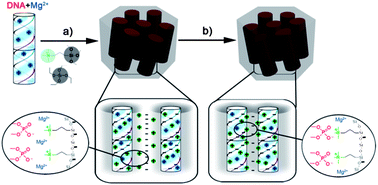Understanding the formation of biologically relevant materials is essential for revealing the structural components of life and assists the development of new functional materials that mimic the state-of-the-art morphologies and structures observed in nature. In this study, we developed an in vitro mineral model system. This system, which was composed of a biomolecule template (DNA), a chiral inducing agent (Mg2+), a co-structure directing agent (N-trimethoxysilylpropyl-N,N,N-trimethylammonium chloride, TMAPS) and a silica source (tetraethoxysilane, TEOS) self-assembled into enantiomeric impeller-like helical DNA–silica complexes (IHDSCs). A right-handed excess impeller-like helical architecture with left-handed DNA chiral packing was produced at a higher reaction temperature (25 °C), whereas a left-handed architecture was synthesised at a lower temperature (0 °C). The pitch length of the IHDSCs was significantly decreased with increasing Mg2+ or TMAPS. The study of the DNA aggregates indicated that the addition of quaternary ammonium (N+) results in the formation of right-handed DNA packing, whereas the presence of Mg2+ results in left-handed DNA packing. Both the handedness and the pitch length of the DNA packing were determined through the competitive interaction between DNA–N+ and DNA–Mg2+. The macroscopic morphological evolution revealed that the impeller-like helical architectures were formed from DNA–silica platelets with parallel DNA packing to the breakage of blades with twisted chiral packing and subsequent growth along the bent blades with decreasing pitch length. The microscopic structural evolution revealed that the enantiomeric IHDSCs were transformed from right-handed DNA chiral packing, which can be reversed into left-handed chiral packing at the higher reaction temperature. Both of the morphological and structural transformations were explained in terms of kinetic charge matching and the competition between DNA–Mg2+/N+–silica wall.

You have access to this article
 Please wait while we load your content...
Something went wrong. Try again?
Please wait while we load your content...
Something went wrong. Try again?


 Please wait while we load your content...
Please wait while we load your content...